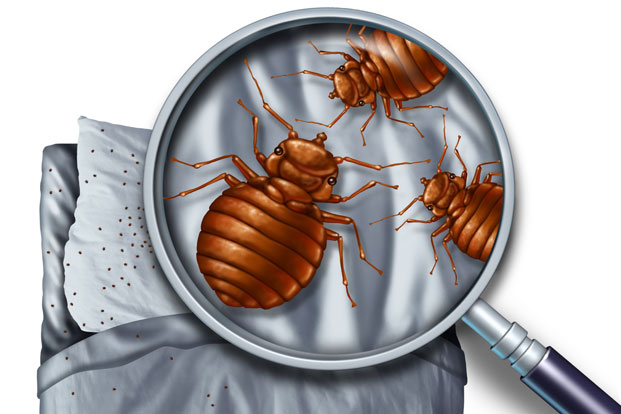They’re the world’s best hitchhikers.
They can hop a ride in a simple fitting room at your favorite store. Or they might hang out on your suitcase in the airport and follow you home.
Soon you’ll itch. You might think it’s an allergic reaction, but the bites will tell a different story.
Is it spiders? Mosquitoes? Fleas?
Nope. It’s an epidemic that’s taken the nation by storm. And it’s not a pretty one. Uh, oh — it’s bed bugs.
The bed bug epidemic has turned heads around the world. These crafty critters have closed down retail stores, infested high end hotels, and even recently shut down a Virginia library.
“Bed bugs (Cimex lectularius) are small, flat, parasitic insects that feed solely on the blood of people and animals while they sleep,” according to the Centers for Disease Control and Prevention. “Bed bugs are reddish-brown in color, wingless, range from 1mm to 7mm (roughly the size of Lincoln’s head on a penny), and can live several months without a blood meal.”
The Telltale Signs of Bed Bugs
The problem is that bed bugs can be tough to find. So even if you have them in your home, you might not know it.
So just how do you find bed bugs?
Rather than looking for actual bites, you want to look for signs that they’ve visited your home. The Environmental Protection Agency says that you need to keep an eye out for the following things:
Rusty or reddish stains on bed sheets or mattresses caused by bed bugs being crushed
Dark spots (about this size: ), which are bed bug excrement and may bleed on the fabric like a marker would
Eggs and eggshells, which are tiny (about 1mm) and pale yellow skins that nymphs shed as they grow larger
Live bed bugs
Where Do Bedbugs Hide?
You also need to know where they hide. The first step to doing this is to look around the bed itself. Check the seams of the mattress and in any cracks and crevices in or near the bed.
It’s also important to check other areas of your home. Look at chairs and couches. Dive into any crevices to see if they’re hiding, and check curtains.
Further, look in things like drawers and appliances. Check behind pictures. And inspect the underside and inside of items in your home.
Remember that these creatures are small, so they’re naturally good at hiding. As the EPA puts it, “if a crack will hold a credit card, it could hide a bed bug.”
The EPA says that there are some important steps that you can take to prevent bed bugs in general. This all begins with protective behaviors in public places, office buildings and the home.
The first step is to put a stop to clutter. “Clutter serves as an ideal habitat for bed bugs, whether at home, school or office,” according to the EPA. “By reducing clutter in your workplace or school, you provide fewer places for the bed bugs to hide and fewer opportunities for them to hitchhike to your home.”
Second, don’t combine your belongings with others’ belongings. “Keep your belongings stowed separately from those of other people. If there is a known problem with bed bugs in the office or school, consider storing your belongings in a plastic bin,” the EPA advises.
Third, keep an eye out for bed bugs in general. “Be vigilant in areas where bed bugs are most likely to be found, which include break rooms, storage areas (coat closets or cubbies), offices or lounges with upholstered furniture, or areas where people may rest,” according to the EPA.
Make a plan in case a bed bug turns up. “Establish a monitoring program so that if a bed bug is found in an area, the status of that area will be formally tracked,” according to the EPA. If you see bed bugs over and over, this could mean someone is bringing them in, or they’ve made a new home in this location.
Also, be wary when it comes to buying secondhand furniture. Check anything you buy for signs of bed bugs. Do this BEFORE you bring this furniture back to your home.
And finally, be careful when it comes to laundromats. Bring your clothes in sealed plastic bags, and don’t fold your clothes there. Put them back into the bag and fold them at home. This gives you the best possible chance to avoid hitchhiking bed bugs.
If you do find that bed bugs have infested an area, you need to know that there’s no overnight cure for the problem. Your best bet is to call an exterminator and schedule multiple treatments.
To get rid of them, a combined approach of both chemical and nonchemical means should be used. “While using one or the other works, it has been found that an approach that uses a combination of both can be the most effective,” according to the EPA. “Using this combination of approaches is often referred to as integrated pest management.”
Though you can choose to “do it yourself,” this isn’t always the most practical option. You may be battling tough factors — like neighbor infestation. If you do choose this route, make a firm plan and stick to it. Identify all areas affected and continue to check for bed bugs after extermination is done.
Regardless of which route you choose, you also need to know that washing clothes alone may not be enough to kill bed bugs hiding in laundry. You should also dry them on high heat for at least 30 minutes. Remember to keep clothes in sealed bags on the way to the laundry room so that bed bugs don’t hop off and infest new areas of the house. Further, vacuum thoroughly and empty the vacuum right after in an area outside the house. And don’t forget to remove and wash and dry curtains.

Leave a Reply